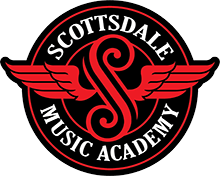You know you’ve got a great rhythm. You see it in your finger snaps, your walking, your attention to sounds and patterns. If you are one of those kids or grownups who likes a great beat and responds well to it, then you might be the right person to take drum lessons in Scottsdale at Scottsdale Music Academy
Playing drums takes a great rhythm, physical stamina and ability to have fun! Most of the drummers you see look like they are having fun, but behind the smiles and laughter comes dedicated practice and a lot of work. Here’s what you need to know to get going on drums.
Types of Drums
When you’re starting to think about taking lessons to learn to play drums, it helps to know the basic parts of a contemporary drumkit. Most music drummers will play a 4-5 piece basic kit when
getting started – here’s are the different drum parts:

- The centerpiece of the drum kit is the large bass drum. A drummer will position his chair to have his dominant leg play the kick pedal that hits the bass drum. Most drummers kick with their right foot to the pedal, which pushes a beater to hit the drum, which creates the booming drum sound.
- The left foot will then alternatively work the hi-hat pedal, which has two smaller cymbals connected on a pole that open and close when the pedal is pressed with the left foot. Drummers will drum with sticks on the hi-hat cymbal, as well as move it with the pedal to create various cymbal patterns in between the bass drum beats.
- The floor tom is a large sized drum that’s usually placed to the right of a drummer’s snare drum. Alternating beats between the snare and the floor tom can provide a heavy tribal sound.
- The snare drum is usually situated on a stand and placed close to the drummer, in order to hit it accurately with sticks, or brushes. In certain rock music, the snare drum is the most important drum in the kit.
- Tom-tom drums are attached generally to the bass drum. Most drummers get by with two different sized tom toms, to give the drum sound more variety.
- The ride cymbal is on a short stand placed near the right of the bass drum, and a crash cymbal, which is on a higher stand over the drums. It’s usually placed in the best spot for the drummer to strike out at it with sticks.
Playing the Drums
Once a drummer sits down on his drum stool, he’s in control. Two sticks in hand, the right foot is ready to work the bass drum kick pedal and the left foot is set to work the hi-hat cymbal pedal. This is the time to try out different patterns. Maybe a drummer has heard in his head a rhythm that alternates between the floor tom and the kick drum. That would give it a deep resonant sound that can then be highlighted with flourishes of cymbals, and an occasional snare drum hit.
It’s probably best to start practicing drums with your favorite songs. You’ll be able to get the basic beat going, even if you don’t have all the drum parts in the right sequences yet. Or, if you’d rather play music with your friends, invite them over and start to make some sounds of your own. Over time, practice and patience will come in handy to tighten up your drum playing with others.
Think you’re ready to learn the drums? Then contact Scottsdale Music Academy to book your first lesson – it’s free! During your instruction, our drum teacher will teach you the basics of keeping rhythm, tuning your drums, how to hold your sticks correctly, playing with the right posture, and getting your brain and your feet in synch. Learning how to play drums is fun! Call us at 602-751-3537 today for your FREE first lesson!

